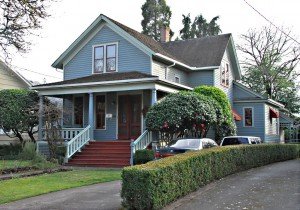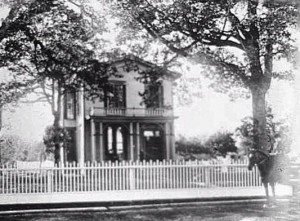In the distribution of Salem land ~ either by the mission or by donation land claims ~ several missionaries and their Lausanne wives, obtained considerable property.
In 1833 Elepha White married Alvan Waller, a circuit riding preacher of the Genessee Conference in NY. In 1840, the family, including the two children Mary and Beverly accompanied him to Oregon on the Lausanne. After building the mill and the earliest buildings at Chemeketa, he was assigned to Willamette Falls and then to the Dalles. The threat of Indian attacks forced the missionaries to race down the Columbia to Oregon City where he purchased a wagon in order to return with his family to the community now called Salem. He was deeded a square mile of land. (From 12th Street east including the original Lee Mission Cemetery and from Mill Creek south to Mill Street.) A son recalled the family living on their farmland raising vegetables, hay and fruit, much of which went to support the Methodist Church and community. Alvan Waller’s subsequent contributions to the Oregon Institute (Willamette University), to the construction of the original Methodist Church and to the founding of the Pacific Christian Advocate were outstanding. Of Elepha’s five children, two sons were lost, one by typhoid and the other by accident. Alvan died in 1872 after catching a cold during a storm when he was attempting to board up the church during its construction.
Elepha survived her husband by a decade, living with her daughter, Julia Stratton, in a fine Queen Anne style house that replaced the original Waller residence. (The Stratton House, now a National Register property, is located at 1588 State Street). When the daughter moved to California, Elepha accompanied her and died there in 1881. Her own home had been moved by Martin Chamberlin, whose sister was married to A. O. Waller, the son of Alvan and Elepha. The Waller house (seen above) was relocated to the corner of 17th and State, then in 1913-16 to its present location at 1658 Court Street in the Court-Chemeketa Historic Residential District where it is known as the Waller-Chamberlin House.
Adelia Judson, a sister of Lewis Judson, had planned to come to Oregon with her husband, Robert Turkington in 1837. After his death, she petitioned her brother to take her with his family, but was refused ~ he had many responsibilities of his own. Just a few days before the Lausanne sailed, she met the only bachelor on the list of passengers, James Olley, and married him. (Details unknown!) Two year after they arrived in Oregon, he drowned. Her third husband (1844) was the widower David Leslie. (Three of David Leslie’s daughters from his first marriage had died in 1843.) Adelia had two daughters during this marriage, Sarah and Emma, but both died by the age of six. In 1857 the fourth Leslie daughter, Mary Jones, died at the birth of her second child.) In 1860, the Leslie property was sold to Asahel Bush, their house (seen here in an early drawing) was occupied by the Bush family until it was moved it to the corner of Cottage and Mission streets. Bush House Museum now stands at original Leslie home location. David and Adelia, along with the surviving daughter, Helen, later relocated to Cottage and Center Streets where David Leslie died in 1869. Helen never married, became a companion to Adelia and died in the same year as her step-mother, 1890.
Adelia’s obituary gives us a glimpse of her personality as reflected in her time:
“At her home, corner of Cottage and Center streets, in this city, Monday evening at 6:45, from a paralytic stroke, Mrs. Adelia J. Leslie, aged 78 years. The death of this beloved woman will be sad news to her many friends who have looked upon her with pride and admiration for the past forty years. She was a devoted christian woman and it was her highest ambition to do some christian act, to aid those in want, or to do some benevolent deed that was instrumental in doing someone good. She came around Cape Horn in 1839, from Vermont, as a missionary teacher, sailed up the Columbia River in 1840 and began her work in that portion of the country known as Missouri bottom. Her name was then Mrs. Adelia Ollie. She was a devoted worker in the cause she came west to labor for and was for several years on of the main teachers. In the 50’s [1844] she was united in marriage to Rev. David Leslie … and took up a donation land claim where Hon. A. Bush now resides…[since Rev. Leslie’s death in 1866] Mrs. Leslie has resided upon the homestead at the corner of Cottage and Center streets. Mother Leslie, as she was familiarly known, has always enjoyed splendid health, but for years has been quite feeble, as she was becoming more aged. Saturday afternoon she made a friendly call on a neighbor and afterward went and took tea with Rev. Rollins and family. About 6 o’clock she departed for home, notwithstanding Rev. Rollins and his wife insisted that she board a streetcar, which would take her to her door. It seems that the good mother did not go directly home, but to Rev. J. Parrish’s and remained until quite late when she started home. About one o’clock Sunday afternoon a young lady stopping at Prof. Arnold’s called upon Mother Leslie’s and upon opening the door was horrified to see the aged mother lying prostrated upon the sitting room floor. She gave the alarm and a number of neighbors came in to render what assistance was possible. She was unconscious when found and despite all efforts never regained consciousness and died at 6:45 yesterday evening. Mrs. Leslie has always had several young ladies boarding with her, but on Saturday evening the ladies were absent and no one was at the house. How long she remained in the condition as when found, is hard to ascertain, but from all probabilities she must have remained on the floor at least fifteen hours. The funeral will be conducted Wednesday at 10 a. m. from the Methodist church, the remains being interred in the I.. O. O. F. cemetery. “
Elizabeth Winn Parrish already had three children when she arrived in Oregon on the Lausanne, one more was born here. With her husband Josiah, a blacksmith and licensed preacher, they made an early home among the four couples who lived in the first house built in Salem, now known as the Jason Lee House. Eventually, Josiah obtained a square mile of land ~ essentially the northeast section of the growing city. This land surrounded his Capitol Street home, built about 1860. (This house, seen above in a 1890s photograph, is now located on Water Street and is a part of the A. C. Gilbert Discovery Village.) They donated the land on which was built the Glen Oak orphans’ home, now the site of one of the buildings of the state hospital.
In January of 1869, Elizabeth donated 4.77 acres from her half of their original donation land claim to make up the original part of Lee Mission cemetery. The cemetery was incorporated by the state of Oregon on January 27. Later that year, Elizabeth died of a “lingering illness” and the obituary gave a description of her steadfast character and her works of community service in that Methodist society:
“Mrs. Parrish has, with others, endured the hardships and perils incident to this then, far off, barbarous, and almost unknown land; many a pioneer has shared the hospitality of her house, while her hands have ministered to their necessities; these on hearing of her death, will drop a tear over the memory of past scenes. As a woman, she possessed a strong mind and commanding mien; a sound discriminating judgment, and a kind heart. As a wife, Mrs. Parrish reverenced her husband, in her, his heart could trust; she did him good, and not evil, all the days of her life, she looked well to her household, and ate not the bread of idleness. Her adorning was modest, not that outward adorning of plaiting the hair and wearing of gold, or putting on extravagant and gaudy apparel; but [wearing} the ornament of a meek and quiet spirit, which is in the sight of God, of great price.
As a mother, few children, if any, ever had a better than her `They will arise up and call her blessed,’ and long will they cherish the memory of her motherly affection, and the words of wisdom and kindness which fell from her lips. As a friend, she was true and could be implicitly confided in; as a neighbor, always obliging; as a Christian, Sister Parrish’s religious experience was comforting and clear, and every where, she adorned her Christian profession. To the sick within her reach, she was ever ready to administer comfort and aid. She clothed the naked, and fed the hungry. She blessed the orphan and wiped his tears. She sympathized with suffering humanity, and relieved it. She was the President of the Ladies Christian Commission Society of Salem, and among others gave of her means to relieve the wounded and suffering soldiers. She was also President of the Children’s Aid Society, and did much to promote its interests. In her last sickness, Sister Parrish suffered as a Christian, patiently trusting in God to the last, and was sustained. She talked freely of her passage to the heavenly state; just on the brink of the ‘stream’ she said, ‘It is but a step over, just a step, and those on the other shore are waiting to welcome me.'”




One Comment